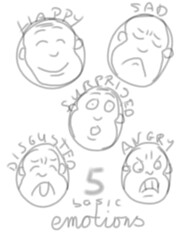Emotion is vital to fiction. Without emotion, our books can read like bad history textbooks: a log of who did what, where, and when. Some history stories are moving enough to catch our imagination, but those are rare.
If we want our readers to care about our stories—our characters—we have to grab our readers (and our characters) by the emotions.
This is something I’ve had to work hard on in my fiction. I’ve usually run under the assumption that my readers could infer how my character felt. Until I got that dreaded feedback: “This scene drags. It’s boring.”
Boring? Boring?! I thought. Can’t you see the emotional turmoil she must be in? The moral dilemma this puts her in?
Um, no, they couldn’t—because I didn’t put it in there. For all they could tell, the character didn’t care. She was impassively watching the scene unfold, or participating without any trouble. Setting up a situation just isn’t enough: you have to show how that situation affects the character as it unfolds, or we’ll have to assume it’s not.
Andrica grabbed the rope with both hands. She stared at the ground thirty feet below her. Her palms slipped a little.
She looked up. Above her, footsteps echoed across the rooftop she’d jumped from. They were going to come after her any minute.
But she could get out of this. She had to. She just needed to think.
No, she needed to act.
She’s in a pretty precarious situation—but do we really care about the outcome?
Andrica grabbed the rope with both hands. Her heart beat in her throat, but the thrill of triumph quickly faded. She dared to peek at the ground below. It should have been only thirty feet down, but her vision swirled dizzyingly. Her stomach plummeted and her clammy palms slipped a fraction of an inch.
She willed herself to look up. Above her, footsteps echoed across the rooftop she’d jumped from. They were going to come after her any minute. Adrenaline sang in her veins, making coherent thought impossible.
But she could get out of this. This time, she had to. Andrica forced a deep breath into her lungs. She just needed to think.
No, Aryn needed her—he needed his mother. She had to act. Now.
Now, not only do we watch what she experiences, but we know what she feels. And if the author does it right, we feel what she feels. And that‘s the way to creating powerful characters and stories.
More emotion resources
I can’t even begin to scratch the surface of getting emotions right in fiction. My top eight reads on emotion in fiction, from blog posts to books:
- My blog series as a free PDF guide, Emotion: it’s tough: it’s tough (the original source of this post!)
- Showing vs. Telling—Feeeeeeeeeelings . . . « KayeDacus.com
- Emotion without Sentiment by Alicia Rasley
- Emotion is Physical by Alicia Rasley
- Empowering Character Emotions course by Margie Lawson
- The Emotion Thesaurus: A Writer’s Guide to Character Expression by Becca Puglisi and Angela Ackerman
- Getting into Character: Seven Secrets a Novelist Can Learn from Actors by Brandilyn Collins
- The Fire in Fiction: Passion, Purpose and Techniques to Make Your Novel Great by Donald Maass
Even more resources on emotion!
Emotion is how we get into our readers’ hearts. Emotion can take our book from “well written” to “captivating.” We read for an experience, and emotion is the best way to convey that experience. In fact, it is the experience.
What do you think? How do you like your emotion in fiction? Come share!
Photo by Steve Ventress

 What are gesture crutches, and why should we avoid them? As
What are gesture crutches, and why should we avoid them? As  I also heartily recommend
I also heartily recommend  ).
). So we can’t just show our character as “in love” or “afraid” all the time—even highly suspenseful or romantic scenes will tend to lose their power when strung together ad nauseam. By incorporating other emotions—even contradictory ones occasionally—we enable our characters to come to life, throw their “main” emotions into relief, and show the many facets of human emotion.
So we can’t just show our character as “in love” or “afraid” all the time—even highly suspenseful or romantic scenes will tend to lose their power when strung together ad nauseam. By incorporating other emotions—even contradictory ones occasionally—we enable our characters to come to life, throw their “main” emotions into relief, and show the many facets of human emotion.


